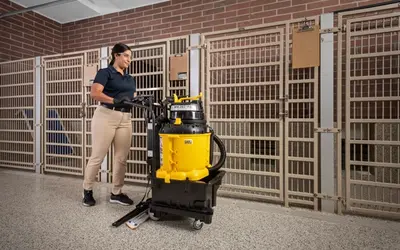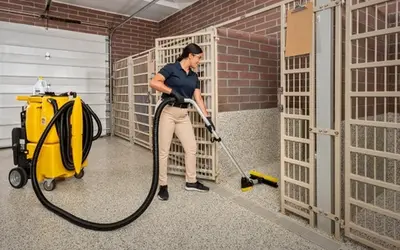Hygienic Green Cleaning - The Next Wave

In the past 10 years the concept of ‘green’ cleaning has progressed from fringe ideology to mainstream philosophy. Cleaning service providers, facilities maintenance managers, building service contractors and others who once dismissed environmentally friendly practices in favor of traditional methods are now embracing the approach, encouraging the next wave – hygienic green cleaning.
Green Cleaning Certification
Green cleaning means different things to different people. Whereas it was once thought to pertain only to adopting environmentally friendly chemicals, today it’s commonly linked to the overall cleaning approach. For example, Green Seal, the leading eco-label in the United States, was once certifying just chemicals when they recognized there is a complete process involved; today Green Seal certifies cleaning processes under GS-42.
Green cleaning certification was an important first step, but since it currently does not track measured soil, microbial and bio-pollution removal outcomes; the lack of performance data does little to dispel the notion held by some experts that green cleaning (ironically) does not effectively remove pathogens or other potentially harmful matter. Removing indoor pollution should be – and is – an integral part of green cleaning.
Integrated Cleaning and Measurement
End-users should – and likely will in this infectious fiscally-constrained era – increasingly require proof of performance benchmarks and measurable results to validate, promote and justify the implementation of green cleaning processes. One system working to provide such data, Integrated Cleaning and Measurement (ICM), is a holistic approach in which best practices are defined by scientific measurement of cleaning.
The ultimate goal of ICM is to provide the cleaning industry with the connection between measured cleaning outcomes and measured health outcomes and quantifiable bottom-line impacts. Once established, it is believed that connection will redefine the conditions surrounding the service purchase, moving from a primary focus on appearance and price to one of health and business impacts.
At its core, ICM is a four-step model: measure, compare, experiment and implement. An open-source system, ICM is not restricted by a single method or product; the system accepts best-practice equipment and approaches no matter the source, provided they are accompanied by measurement data confirming their effectiveness compared to other methods.
ICM-based ‘hygienic green cleaning’ adds the quantification of organic (germ promoting or containing) and other matter removal to the overall cleaning process, allowing for objective correlations between cleaning efficacy and various outcomes. ICM works to unify various elements, rather than keeping them separate or isolated; as more information is gathered and more studies performed, this progressive system will provide a clearer picture of these correlations.
Studies on the Benefits of Cleaning
In 2004, Dr. Charles P. Gerba, PhD., conducted a blind study titled ‘Cleaning Desktops and Other Classroom Surfaces Reduces Absenteeism,’ in which quaternary ammonium disinfecting wipes were used on various surfaces to determine if the regular use of wipes reduced bacterial levels. Six elementary school classrooms comprising 148 students were selected in a school in the Seattle area. Half were part of the intervention study, while the other half comprised the control group.
Interestingly, the study found that classrooms undergoing daily intervention with disinfectant wipes were found to have a statistically significant reduction in student absenteeism due to illness. Except for a single week in which no students were absent from any of the classrooms in the study, a total of at least two students were absent from the intervention classrooms and a total of at least four students were absent from the control classrooms in each week of the study.
Similarly, a study conducted at the Association for Children with Downs Syndrome School in Bellmore, N.Y., by Dr. Leonard Krilov, examined the health implications associated with improved cleaning. Dr. Krilov tracked the health and attendance impacts after the program was implemented and found that the improved cleaning reduced total illnesses by 24%, doctor visits by 34%, courses of antibiotics by 24% and days absent from school by 46%.
Cleaning Challenges in Healthcare Facilities
Healthcare facilities, like schools, face significant cleaning challenges. Infections being transmitted via contaminated surfaces deserve particular scrutiny, as antibiotic-resistant pathogens circulate in these facilities at a disproportionate rate.
Many operating room floors, restroom floors and other areas are still being cleaned with the traditional mop and bucket. Based on ICM data on organic soil removal, the method is often substandard when compared to spray-and-vac systems and other technologies; it all but ensures some level of cross-contamination will occur as the operator moves from one area to another. Even when mop heads are consistently swapped out for new ones, the inefficiencies of the process – and the tendency for mops to move dirt around instead of removing it, as well as leaving it in grout lines – will result in soil and bacterial buildup on the flooring surface.
Room for Measured Improvement
According to Paul S. Darby MD, PhD, MPH: ‘The traditional cleaning method essentially turns a restroom floor into a very large culture plate, supplying ample water and nutrition to disease-causing organisms that can rapidly proliferate. As the numbers of organisms rise exponentially, the probability that an infective load will be transferred to a person’s skin by a single contact likewise rises because infections generally require a threshold number of organisms to be exceeded before disease results. The spray-and-vac method has the ability to prevent such conditions required for bacterial proliferation and disease transmission.’
The problems go beyond the equipment. Liquid chemical disinfectants containing sodium hypochlorite, quaternary ammonium compounds, and phenols are traditionally used to mitigate the risk of surface-mediated infectious disease transmission, according to Dr. Benjamin Tanner, PhD., president of Antimicrobial Test Laboratories, but these technologies are not always practical or effective because of lengthy contact or ‘dwell’ times, the potential for interference by antagonistic factors, allergenic attributes, and the inability of the chemicals to disinfect certain types of porous surfaces.
In his study ‘Practical, Rapid Technology for Disinfection of Environmental Surfaces,’ Dr. Tanner evaluated the efficacy and practicality of a dry steam vapor disinfection system with a proprietary nano-crystalization module for disinfection of institutional surfaces. He found that ‘the system is efficacious against a wide range of problematic microorganisms at a much briefer contact times than those required for traditional disinfectants,’ which holds obvious promise for CSPs and other professionals operating in areas where time and traffic constraints limit cleaning options.
Hygienic Green Cleaning: the Next Step
Hygienic green cleaning, utilizing the ICM model, is the next step up the green cleaning ladder. As more and more manufacturers, institutions and organizations support the concept of ICM and the link between measurable contaminate levels and health outcomes and fiscal impacts, the effort to have cleaning evaluated from a health and business perspective will continue to grow.
Related Posts

The Best Dog Kennel Cleaning Equipment
There are ways to simplify the kennel cleaning process. Automatic kennel cleaning equipment can simplify the kennel cleaning process and can save hours of daily, back breaking labor–even for facilities without central drains.
Read more
A Better Retail Floor Care Option: How One National Retailer Reclaimed Floor Care
Discover how a national retailer cut costs and improved results by switching to Kaivac’s All Floor™ system—an easy, all-in-one floor care solution perfect for low-revenue retail locations.
Read more
The Prodigal Pooch Loses Odors, Gains Clients Thanks To No-Touch Cleaning System
The change at The Prodigal Pooch was immediate. After just two days of using No-Touch Cleaning the look, smell, and feel in the kennel rooms improved. Two weeks later the odor was completely gone.
Read more